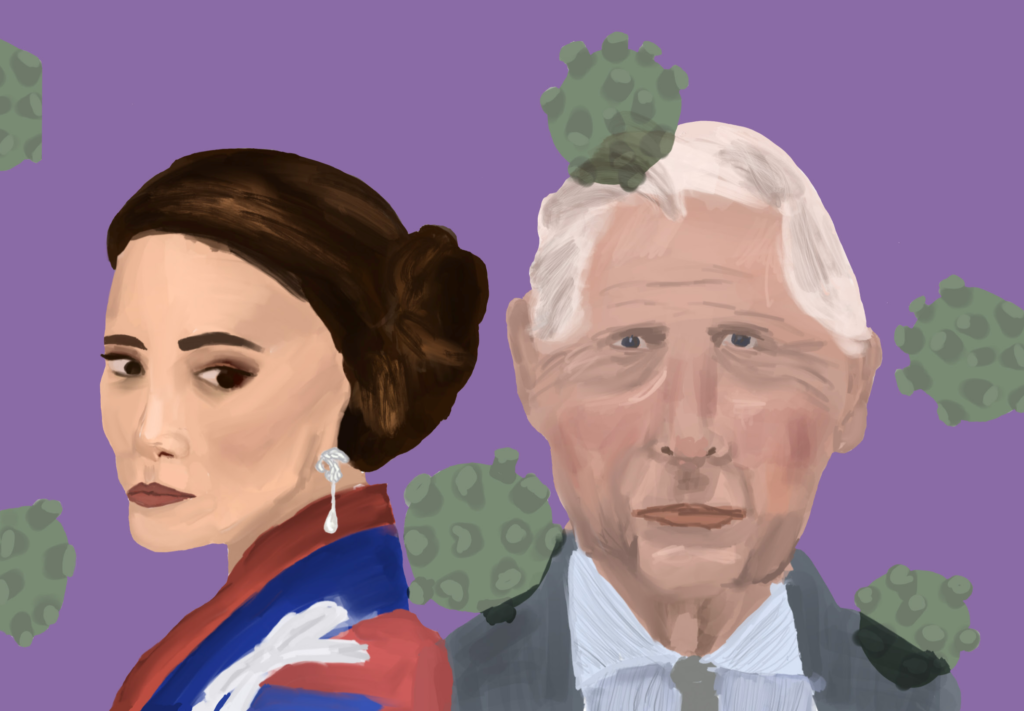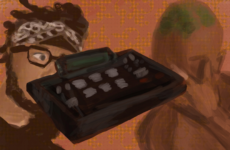
Graphic by Rielle Reyes ’27/The Choate News
By Francesca Howard ’26
The late Queen Elizabeth II famously said that “the royals have to be seen to be believed.” Recent events have only proven her right. Chances are, you have probably heard about the recent debacle with the British royal family — specifically, the insensitive remarks made about Princess of Wales Catherine Middleton’s hidden cancer diagnosis. This event highlights how blatant invasions of privacy have been normalized and there must be a change in these online habits.
Since her introduction to royal life in 2011, Princess Catherine (or ‘Kate’) has been turning heads. However, as of this January, public interest in the princess has reached new heights. The princess is back in the limelight, ironically, by stepping out of it.
It all began when Kensington Palace stated that the princess had abdominal surgery on January 16. They assured everyone that the princess was in good health but would be hospitalized. They also mentioned she wouldn’t be back on royal duties until after Easter.
Despite this, by mid-February — well before Easter — rumors and conspiracy theories had already begun to swirl. Initially, the publicity sprang from a place of concern. For a figure who has graced the public eye for over a decade, the princess’ departure made people speculate about her wellbeing. The princess had not been seen publicly since Christmas, despite her husband, Prince William, routinely attending public events. When a picture of the princess released by the palace for Mother’s Day was revealed to have been edited by Catherine herself, the public was more dubious than ever.
In a lighthearted attempt to clear the air in mid-March, the princess apologized for any mix-up, quipping, “Like many amateur photographers, I do occasionally experiment with editing,” on X, formerly known as Twitter. But this apology did little to calm the storm of internet sleuths and royal enthusiasts. Instead, it made them even more determined to unearth the truth behind the princess’s absence.
As the months passed, attempts to uncover the truth about Catherine grew more malicious. Hearsays, conspiracies, and deepfakes were ubiquitous over various media platforms. Everyone, it seemed, was confident that they figured out what was going on with the princess, and, as it always is on the internet, the hotter the take, the better. Rumors ranged from the somewhat reasonable to the downright ludicrous (the princess did not, in fact, get a Brazillian butt lift).
After months of speculation, the internet trolls got what they wanted: the truth. The princess was not in a coma. She did not get cheated on. She was not the famous street artist Banksy. The princess has cancer.
This revelation was met with a deluge of apologies. “Omg we are all douchebags,” one viral post read. “I’m going to hell,” another said. Everyone felt bad, and rightfully so. Catherine wanted to quiet all the noise while she recuperated, both for her and her children’s sake, but unfortunately, she was unable to.
The situation probably would not have gotten so out of hand if not for the utter ineptitude of the royal family’s media team. Transparency, or the lack thereof, has often been the Achilles’ heel of the royal family. The family’s decision to release a manipulated photo to quell rumors fed into the speculation they aimed to dispel. The moment there’s an information gap, people will fill it.
Some argue that Catherine signed up for this level of scrutiny the moment she took on her title. However, just because she has a royal crown does not make her less entitled to dignity. We need to remember that famous people have their own lives behind the dishes served to the public cooked up by the media. The expectation that public figures must lay bare every facet of their lives, especially personal health matters, is unreasonable and dangerously voyeuristic.
This situation warrants those who were involved to reflect on their carelessness. Are people so bored with themselves that they have nothing better to do than bully a sickly mother of three children online? While such speculation is not new, and each theory was wildly divergent, they all share one thing: they reveal a voracious public appetite for scandal. In fact, Catherine was not a one-off event. The Brits have always loved a good scandal.
Before she even took to the royal stage, Princess Diana of Wales had already won over the public, quickly becoming hailed as “The People’s Princess.” Her genuine warmth and compassion set her apart from the royal family, which was otherwise seen as out of touch. Diana wanted to use her power to enact positive change in her community, all while rocking some seriously iconic outfits. Despite the praise, Diana was no stranger to scrutiny. Everything from her fashion choices to her dysfunctional relationship became a subject of global fascination. Even in death, Diana hasn’t found peace. To this day, the public continues to dissect every aspect of her life, trying to get to the heart of who Diana really was.
History repeated itself in 2016 with the next social pariah of the royal family: Meghan Markle. Markle took the public by storm when her relationship with Prince Harry was first confirmed. In an interview with Oprah Winfrey, Markle rocked the boat, discussing her experiences with racism within the royal institution and a lack of support for her mental health struggles. But such attention soon backfired with allegations of Markle bullying royal staff, which she and Harry later denied. Other conspiracies soon arose, ranging from the plausible to the not-so-plausible. Markle was said to have seduced her way into the spotlight in order to garner more media recognition and advance her career goals. She became the classic gold digger in the eyes of the people. From Princess Diana to Princess Catherine, the public’s obsession with the royal women has been unending.
One can’t say the same for the royal men. King Charles III, for instance, has been undergoing similar treatments for an undisclosed form of cancer, and yet I don’t see conspiracies around his supposed Brazilian butt lift and facelift. The post-surgery scrutiny the princess was under far outweighs anything directed at the ruling monarch over his arguably more dire situation.
We cannot be absolved of blame. Everyone, myself included, who spiraled down internet rabbit holes and jumped to conclusions based on unsubstantiated theories should feel ashamed. I’m not saying we shouldn’t ask questions —however, we should do so in a way that is respectful, empathetic, and humble. We can be skeptical without resorting to hyperbolic and uncorroborated accusations. What I’ve taken away from this fiasco is that behind the clickbait, there are real people whose lives do not serve the sole purpose of amusing others.




